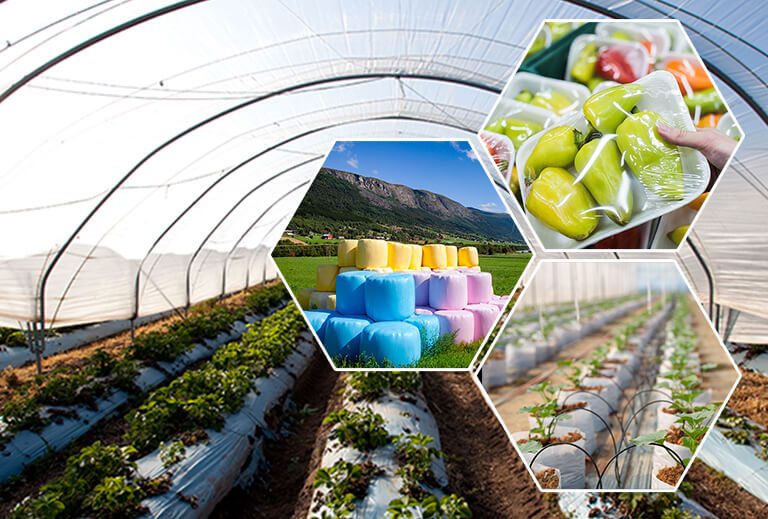The Modern Integration of Plastics in Agriculture
The practice of using plastic materials in agricultural applications is known as plasticulture.
“Ag plastics” is a term used to describe a variety of plastic materials in this sector. Soil fumigation film, irrigation drip tubing, farm ponds, greenhouse cultivation, plastic plant packaging cable, nursery pots, and bales are all examples of ag plastics. However, the phrase is most commonly used to represent all types of plastic plant/soil covers. Plastic mulch, row covers, high and low tunnels (polytunnels), and plastic greenhouses are examples of such coverings.
In India, 7.4 million tons of plastics were used in agriculture in 2019.
Why is plasticulture being used by farmers?
The Ministry of Agriculture believes that putting it to its best use will help it accomplish its overall goal of tripling farm income by 2022.
Plasticulture’s main advantages include:
- Increase in crop yields, which is expected to result in increased food grain production and a 4% increase in farm GDP.
- Water and other agricultural inputs such as agrochemicals and fertilizers are conserved.
- Plasticulture can be ingested in the mainframe system as part of sustainable agriculture approaches.
What purpose does plasticulture have for farmers?
Silage Storage
As plastics are lightweight, silage may be kept for long periods of time and transferred to different locations. Silage is stored in plastic films that are lightweight and resistant to harsh temperatures.
Irrigation Systems and Reservoirs
Plastic irrigation systems and reservoirs, when used together, have made a significant contribution to water management. Water may be stored easily and kept leak-free by covering it with plastic materials. The water can then be supplied to water circulation and irrigation systems via plastic PVC pipes.
Mulching
Mulching is the technique of covering the soil in order to prevent it from degrading over time. Plastic sheets are used to keep the humidity high and prevent water from evaporating from the soil. This also improves the thermal conditions and retains the soil’s nutrients.
Low Tunnels>
Low tunnels are formed of plastic nets and function similarly to greenhouses, with the exception of their height and complexity. Crops can be protected from insects and bad weather using these plastic netting.
>What other possibilities do we have?
Alternative natural materials derived from plants and animals, as well as newer generation bio-polymers (plastics manufactured from biomass), are available. A recent United Nations research study discusses both traditional plastic alternatives, such as paper, cotton, and wood, as well as less obvious alternatives, such as algae, fungi, and pineapple leaves, among others.
We know how plastics have aided the agricultural industry over time. Plastics will continue to play an important part in agriculture and generate new innovations through suitable recycling procedures. As a result, state and national governments must step in to encourage good and responsible behavior.
Leave a Reply Cancel reply
Recent Posts
- Understanding The Materials That Are Used To Build Plastic Toys
- All You Need To Know About Food-grade Plastics
- A Glance At The Materials That Boost The Performance Of Plastics
- Understanding The Importance Of Exploring New Business Opportunities In The Plastic Industry
- Understanding The Importance Of Investing in R&D For The Plastic Industry
Categories
- 3D Printing
- AIPMA
- Automation
- Automobile Sector
- Bio Plastics
- Environment
- Innovations In Recycling
- Latest Innovations
- Molds & Dies
- News
- Packaging Industry
- Plastic
- Plastic Application
- Plastic Industry
- Plastic Market
- Plastic Myths
- Plastic News From The World
- Plastic Packaging
- Plastic Products
- Plastic Recycling
- Plastic Solar Cells
- Plastic Toys
- Plastic Waste
- Plastic World
- Plastics
- Plastics And Their Applications
- Plastics In Agriculture
- Plastics In Healthcare
- Plastics In Medical Industry
- Plasticulture
- Processing Machinery
- Recycling Machines
- Robotics
- Uncategorized
- Virtual Reality
Archives
- November 2023 (3)
- October 2023 (2)
- September 2023 (3)
- August 2023 (3)
- July 2023 (3)
- June 2023 (3)
- May 2023 (2)
- April 2023 (2)
- March 2023 (2)
- February 2023 (2)
- January 2023 (2)
- December 2022 (3)
- November 2022 (1)
- October 2022 (1)
- September 2022 (2)
- August 2022 (1)
- July 2022 (3)
- May 2022 (3)
- March 2022 (2)
- February 2022 (1)
- January 2022 (1)
- September 2021 (2)
- August 2021 (3)
- July 2021 (4)
- June 2021 (4)
- May 2021 (3)
- April 2021 (2)
- March 2021 (4)
- November 2019 (8)
- October 2019 (8)
- September 2019 (8)
- August 2019 (8)
- July 2019 (8)
- June 2019 (8)
- May 2019 (8)
- April 2019 (8)
- March 2019 (8)
- February 2019 (11)
- January 2019 (8)
- December 2018 (8)
- November 2018 (12)
- October 2018 (12)

